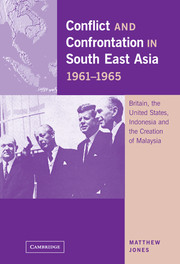 Conflict and Confrontation in South East Asia, 1961–1965
Conflict and Confrontation in South East Asia, 1961–1965 Published online by Cambridge University Press: 25 July 2009
The idea of a negotiated resolution to the tensions produced by the formation of Malaysia was certainly welcome to the architects of the Kennedy Administration's accommodating approach to Indonesia. There would be little likelihood of assembling international backing for a package of financial assistance for the Indonesian economy when the leadership in Jakarta was promoting insurgency against its Western-orientated Malayan neighbour and indulging in virulent anti-imperialist rhetoric. Moreover, the Indonesian Government was responding only slowly to the IMF's conditions that a stabilization plan, involving a real effort to reduce expenditures and balance the budget, should be put in place before large-scale Western financial help to ease chronic shortages of foreign exchange could be authorized. Compounding this difficulty was the fact that strong criticisms within the United States were now being directed at the Administration's handling of relations with Indonesia, and in particular, its readiness to extend further aid to Sukarno's regime.
Much to the consternation of US officials, in March 1963 the Clay Committee had delivered its comprehensive and critical report on the foreign aid programme. This investigation had been instigated by President Kennedy after the congressional mauling inflicted on the 1962 aid bill, and widespread dissatisfaction with the work of the Agency for International Development. The expectation had been that a specially selected panel, including several business-minded and conservative members, under the respected guidance of General Lucius Clay, would look over existing programmes with a faintly critical eye, and then reach the considered verdict that they were necessary to national security.
To save this book to your Kindle, first ensure no-reply@cambridge.org is added to your Approved Personal Document E-mail List under your Personal Document Settings on the Manage Your Content and Devices page of your Amazon account. Then enter the ‘name’ part of your Kindle email address below. Find out more about saving to your Kindle.
Note you can select to save to either the @free.kindle.com or @kindle.com variations. ‘@free.kindle.com’ emails are free but can only be saved to your device when it is connected to wi-fi. ‘@kindle.com’ emails can be delivered even when you are not connected to wi-fi, but note that service fees apply.
Find out more about the Kindle Personal Document Service.
To save content items to your account, please confirm that you agree to abide by our usage policies. If this is the first time you use this feature, you will be asked to authorise Cambridge Core to connect with your account. Find out more about saving content to Dropbox.
To save content items to your account, please confirm that you agree to abide by our usage policies. If this is the first time you use this feature, you will be asked to authorise Cambridge Core to connect with your account. Find out more about saving content to Google Drive.